Om Gan Ganpataye Namo Namah
Have you ever been stunned by the astounding number of gods and goddesses in Hindu mythology?
In fact, multiple forms of the same deity exist, and it can be challenging to keep up with all of them.
This blog will explore the difference between Lord Ganesha and Mahaganapathi. It is not hard to love and respect Lord Ganesha. He is probably the most beloved god of all, perhaps due to his benevolent nature and the fact that we always begin any new auspicious activities by paying homage to him.
While Ganesha and Mahaganapathi are revered as symbols of wisdom, prosperity, and obstacle removal, subtle distinctions exist in their portrayal and significance.
Understanding these differences sheds light on the diverse aspects of their divine personas and enriches our spiritual journey.
So, it is only fitting to learn about Ganesha and his different forms—in this case, Mahaganapathi.
Suggested read:
Ganesh Chaturthi 2022: Understanding and Connecting With Lord Ganesha
Legend of Lord Ganesha and Mahaganapathi
Significance of Mahaganapathi
Maha Ganapati is the thirteenth of the 32 forms of Lord Ganesha, known as ‘the great Ganesha’ because of his significant stature and powers. This form of Ganesha closely resembles his father, Lord Shiva, featuring three eyes and a crescent moon on his head.
Maha Ganapati is depicted as bright red, sitting with his consort on his left lap, and has ten hands. In these hands, he holds various symbolic items: his broken tusk, a discus, a mace, a noose, a sugarcane bow, a sprig of paddy, a lotus, a blue lily, a pomegranate, and a pot of precious gems called a Ratna Kumbha.
You can see paintings of Maha Ganapati in Thiruvananthapuram, the capital of Kerala, and sculptures in some temples in the Mysore region.
Additionally, an idol of Maha Ganapati is worshipped in the famous Krishna temple at Dwaraka in Gujarat, where Lord Krishna himself is said to have prayed to him. The Pushya Nakshatra, also known as Star Poosam, is associated with this form of Ganapati.
Mahaganapati is revered as the supreme deity in the Ganapatya sect, a tradition that worships Ganesha above all other gods. He is known as the giver of wealth and happiness and is sought after by his devotees for removing obstacles from their lives.
Worshipping Maha Ganapati is believed to bring significant benefits, including immense merit and prosperity. Regular prayers to Maha Ganapati can help devotees achieve success and glory.
There is also a particular mantra for Maha Ganapati that praises his form and seeks his blessings for grace. Chanting this mantra faithfully is an effective way to honor this powerful deity. Here is the mantra:
“Hastheendhraanan mindhuchoodmaroona chchaayam trinetramrasaath
Aashlishtam piryayaasapadhmakarayaa svaanthasthayaa samsthitham Beejaapoorakadhekshu kaarmukalasath chaktraabja paashothpala Vreehyaagrasva vishaanratnakalashaan hasthairva hanthambhaje.”

Dr. Manmeet Kumar is a Spiritual Coach who founded Soul Miracles in 2016. She uses her gifts of being a psychic and a medium to enable others to transform their inner core.

